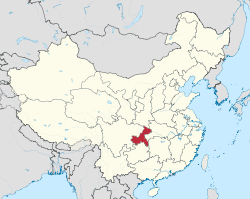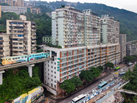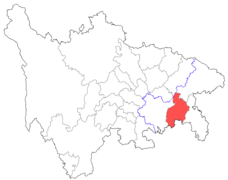
A | B | C | D | E | F | G | H | CH | I | J | K | L | M | N | O | P | Q | R | S | T | U | V | W | X | Y | Z | 0 | 1 | 2 | 3 | 4 | 5 | 6 | 7 | 8 | 9
Chongqing
重庆 Chungking | |
|---|---|
 | |
 Location of Chongqing Municipality within China | |
| Coordinates (Chongqing municipal government): 29°33′49″N 106°33′01″E / 29.5637°N 106.5504°E | |
| Country | China |
| Settled | c. 316 BC |
| Separated from Sichuan | 14 March 1997 |
| Municipal seat | Yuzhong District |
| Divisions - County-level - Township-level | 26 districts, 12 counties |
| Government | |
| • Type | Municipality |
| • Body | Chongqing Municipal People's Congress |
| • Party Secretary | Yuan Jiajun |
| • Congress Chairperson | Wang Jiong |
| • Mayor | Hu Henghua |
| • Municipal CPPCC Chairperson | Cheng Lihua |
| • National People's Congress Representation | 58 deputies |
| Area | |
| • Municipality | 82,403 km2 (31,816 sq mi) |
| • Built up area | 5,472.8 km2 (2,113.1 sq mi) |
| Elevation | 244 m (801 ft) |
| Highest elevation | 2,797 m (9,177 ft) |
| Population (2020 census (total), 2018 (otherwise))[4] | |
| • Municipality | 32,054,159 |
| • Density | 390/km2 (1,000/sq mi) |
| • Urban | 22,251,500[note 1][2] |
| • Built up area | 9,580,770[3] |
| GDP(2023) [5] | |
| • Municipality | CN¥ 3,015 billion (17th) US$ 428 billion |
| • Per capita | CN¥ 94,135 (10th) US$ 13,359 |
| Time zone | UTC+8 (CST) |
| • Summer (DST) | UTC+9 (CDT) |
| Postal codes | 4000 00 – 4099 00 |
| Area code | 23 |
| ISO 3166 code | CN-CQ |
| – Growth | |
| Abbreviation | CQ / 渝; Yú |
| Climate | Cfa |
| HDI (2021) | 0.774[6] (11th) – high |
| Website |
|
| Symbols | |
| Flower | Camellia japonica[7] |
| Tree | Ficus lacor[8] |
| Chongqing | |||||||||||||||||||||||||||||||||||||||||||
|---|---|---|---|---|---|---|---|---|---|---|---|---|---|---|---|---|---|---|---|---|---|---|---|---|---|---|---|---|---|---|---|---|---|---|---|---|---|---|---|---|---|---|---|
 "Chongqing" in Simplified (top) and Traditional (bottom) Chinese characters | |||||||||||||||||||||||||||||||||||||||||||
| Simplified Chinese | 重庆 | ||||||||||||||||||||||||||||||||||||||||||
| Traditional Chinese | 重慶 | ||||||||||||||||||||||||||||||||||||||||||
| Postal | Chungking | ||||||||||||||||||||||||||||||||||||||||||
| Literal meaning | "Doubled Celebration" | ||||||||||||||||||||||||||||||||||||||||||
| |||||||||||||||||||||||||||||||||||||||||||
Chongqing[a] is a municipality in Southwestern China. Chongqing is one of the four direct-administered municipalities under the Central People's Government, along with Beijing, Shanghai, and Tianjin. It is the only directly administrated municipality located deep inland.[13] The municipality covers a large geographical area roughly the size of Austria,[14] which includes several disjunct urban areas in addition to Chongqing proper. Due to its classification, the municipality of Chongqing is the largest city proper in the world by area, though it does not have the largest urban area.
The municipality of Chongqing is the only Chinese municipality with a resident population of over 30 million;[15] however, this number includes its large rural population.[16] In 2020, Chongqing surpassed Shanghai as China's largest municipality by urban population; as of 2022[update], it has an urban population of 22.8 million.[15] The municipality contains 26 districts, 8 counties, and 4 autonomous counties. The city served as the wartime capital for the Republic of China (ROC) during the Second Sino-Japanese War (1937–1945). On 14 March 1997, the current municipality was separated from the surrounding province of Sichuan, with the goal of furthering development in the central and western parts of the country.[17] University of Washington professor Kam Wing Chan argued that Chongqing's status is more akin to that of a province rather than a city.[14]
As one of China's National Central Cities, Chongqing serves as a center for finance in the Sichuan Basin and the upstream Yangtze, as well as for manufacturing and transportation. It is a connection in the Yangtze River Economic Belt and a base for the country's Belt and Road Initiative.[18] Chongqing Jiangbei International Airport is the second-busiest airport in China, and is one of the top 50 busiest airports in the world.[19][20] The city's monorail system is the world's longest and busiest, as well as having the greatest number of stations, with 70.[21][22] Chongqing is ranked as a Beta (global second-tier) city.[23] It is the headquarters of the Changan Automobile, one of the "Big Four" car manufacturers of China.[24] As of 2023[update], the city hosts 12 foreign representations, the fifth-most in China behind Beijing, Shanghai, Guangzhou, and Chengdu.[25] It is one of the top 40 cities globally by scientific research output, as tracked by the Nature Index;[26] the municipality is home to several notable universities, including Chongqing University, Southwest University, and Chongqing Normal University.[27][28]
History
Antiquity
Chongqing's location is historically associated with the State of Ba. Its capital was first called Jiangzhou (江州).[29]
Imperial era
Jiangzhou subsequently remained under Qin Shi Huang's rule during the Qin dynasty, the successor of the Qin State, as well as the rule of Han dynasty emperors. Jiangzhou was subsequently renamed during the Northern and Southern dynasties to Chu Prefecture (楚州), then again in 581 AD (Sui dynasty) to Yu Prefecture (渝州), and later in 1102 during Northern Song to Gong Prefecture (恭州).[30] The name Yu however survives to this day as an abbreviation for Chongqing, as well as for the city's historic center, where the old town once stood; its name is Yuzhong (渝中, Central Yu).[29] It received its current name in 1189, after Prince Zhao Dun of the Southern Song dynasty described his crowning as king and then Emperor Guangzong as a "double celebration" (simplified Chinese: 双重喜庆; traditional Chinese: 雙重喜慶; pinyin: shuāngchóng xǐqìng, or chóngqìng in short). To mark the occasion of his enthronement, Yu Prefecture was therefore converted to Chongqing Fu.
In 1362 (during the Yuan dynasty), Ming Yuzhen, a peasant rebel leader, established the Daxia Kingdom (大夏) at Chongqing for a short time.[31] In 1621 (during the Ming dynasty), another short-lived kingdom of Daliang (大梁) was established by She Chongming (奢崇明) with Chongqing as its capital.[32] In 1644, after the fall of the Ming dynasty to a rebel army, Chongqing, together with the rest of Sichuan, was captured by Zhang Xianzhong, who was said to have massacred a large number of people in Sichuan and depopulated the province, in part by causing many people to flee to safety elsewhere. The Manchus later conquered the province, and during the Qing dynasty, immigration to Chongqing and Sichuan took place with the support of the Qing emperor.[33]
In 1890, the British Consulate General was opened in Chongqing.[34] The following year, the city became the first inland commerce port open to foreigners, with the proviso that foreign ships should not be at liberty to trade there until Chinese-owned steamers had succeeded in ascending the river. This restriction was abolished by the Treaty of Shimonoseki in 1895, which declared the city open on the same terms as other ports, although it was not until 1907 that a steamship made the journey without the help of manual haulers.[35] From 1896 to 1904, the American, German, French, and Japanese consulates were opened in Chongqing.[36][37][38][39]
Provisional wartime capital of the Republic of China

During and after the Second Sino-Japanese War, from November 1937 to May 1946, it was Generalissimo Chiang Kai-shek's provisional capital. After the General and remaining army had lived there for a time following their retreat in 1938 from the previous capital of Wuhan, it was formally declared the second capital city (陪都; péidū; p'ei2-tu1) on 6 September 1940.[40] After Britain, the United States, and other Allies entered the war in Asia in December 1941, one of the Allies' deputy commanders of operations in South East Asia (South East Asia Command SEAC), Joseph Stilwell, was based in the city. This made it a city of world importance in the fight against Axis powers, together with London, Moscow and Washington, D.C.[41]
The city was also visited by Lord Louis Mountbatten, the Supreme Commander of SEAC which was itself headquartered in Ceylon, modern day Sri Lanka. Chiang Kai Shek as Supreme Commander in China worked closely with Stilwell.[42] From 1938 to 1943, the city suffered from continuous massive bombing campaigns of the Imperial Japanese Navy and Army Air Forces; battles of which were fought entirely by the Chinese Air Force squadrons and anti-aircraft artillery units.[43][44] Many lives were saved by the air-raid shelters which took advantage of the mountainous terrain. Chongqing was acclaimed to be the "City of Heroes" due to the indomitable spirits of its people as well as their contributions and sacrifices during the War of Resistance-World War II. Many factories and universities were relocated from eastern China and ultimately to Chongqing during years of setbacks in the war, transforming this city from inland port to a heavily industrialized city. In late November 1949, the Nationalist KMT government retreated from the city.[45]
Municipality status
- Location maps of Chongqing, Fuling, Wanxian, Qianjiang prefectures in Sichuan before 1997

On 14 March 1997, the Eighth National People's Congress decided to merge the sub-provincial city with adjacent Fuling, Wanxian, and Qianjiang prefectures that it had governed on behalf of the province since September 1996, and grant it independence from Sichuan. The resulting single entity became Chongqing Municipality,[46]: 74 containing 30,020,000 people in forty-three former counties (without intermediate political levels). The municipality became the spearhead of China's effort to develop its western regions and to coordinate the resettlement of residents from the reservoir areas of the Three Gorges Dam project. Its first official ceremony took place on 18 June 1997.
On 8 February 2010, Chongqing became one of the four National Central/Core cities, the other three are Beijing, Shanghai and Tianjin.[47] The same year on June 18, the Liangjiang New Area was established in Chongqing, which was the third state-level new area at the time of its establishment.[48]
Geography

Physical geography and topography

Chongqing is situated at the transitional area between the Tibetan Plateau and the plain on the middle and lower reaches of the Yangtze River in the sub-tropical climate zone often swept by moist monsoons. It often rains at night in late spring and early summer, and thus the city is famous for its "night rain in the Ba Mountains", as described by poems throughout Chinese history including the famous Written on a Rainy Night-A Letter to the North by Li Shangyin.[49] The municipality reaches a maximum length of 470 km (290 mi) from east to west, and a maximum width of 450 km (280 mi) from north to south.[50] It borders the following provinces: Hubei in the east, Hunan in the southeast, Guizhou in the south, Sichuan in the west and northwest, and Shaanxi to the north in its northeast corner.[51]

Chongqing covers a large area crisscrossed by rivers and mountains. The Daba Mountains stand in the north, the Wu Mountains in the east, the Wuling Mountains in the southeast, and the Dalou Mountains in the south. The whole area slopes down from north and south towards the Yangtze River valley, with sharp rises and falls. The area is featured by a large geological massif, of mountains and hills, with large sloping areas at different heights.[52] Typical karst landscape is common in this area, and stone forests, numerous collections of peaks, limestone caves and valleys can be found in many places. The Longshuixia Gap (龙水峡地缝), with its natural arch-bridges, has made the region a popular tourist attraction. The Yangtze River runs through the whole area from west to east, covering a course of 665 km (413 mi), cutting through the Wu Mountains at three places and forming the well-known Three Gorges: the Qutang, the Wuxia and the Xiling gorges.[53] Coming from northwest and running through "the Jialing Lesser Three Gorges" of Libi, Wentang and Guanyin, the Jialing River joins the Yangtze in Chongqing.[54]
Leaving at dawn the White Emperor crowned with cloud,
I've sailed a thousand li through canyons in a day.
With the monkeys' adieus the riverbanks are loud,
My skiff has left ten thousand mountains far away.
The central urban area of Chongqing, or Chongqing proper, is a city of unique features. Built on mountains and partially surrounded by the Yangtze and Jialing rivers, it is known as a "mountain city" and a "city on rivers".[55] The night scene of the city is very illuminated, with millions of lights and their reflection on the rivers. With its special topographical features, Chongqing has the unique scenery of mountains, rivers, forests, springs, waterfalls, gorges, and caves. Li Bai, a famous poet of the Tang dynasty, was inspired by the natural scenery and wrote this epigram.[56]
Specifically, the central urban area is located on a huge folding area. Yuzhong District, Nan'an District, Shapingba District and Jiangbei District are located right on a big syncline. And the "Southern Mountain of Chongqing" (Tongluo Mountain), along with the Zhongliang Mountain are two anticlines next to the syncline of downtown.[57]
Zhongliang Mountains (中梁山) and Tongluo Mountains (铜锣山) roughly forms the eastern and western boundaries of Chongqing's urban area. The highest point in downtown is the top of Eling Hill, which is a smaller syncline hill that separates the Yangtze River and Jialing River. The elevation of Eling Hill is 379 m (1,243 ft). The lowest point is Chaotian Gate, where the two rivers merge with each other. The altitude there is 160 m (520 ft). The average height of the area is 259 m (850 ft). However, there are several high mountains outside central Chongqing, such as the Wugong Ling Mountain, with the altitude of 1,709.4 m (5,608 ft), in Jiangjin.
Climate

Chongqing has a monsoonal humid subtropical climate (Köppen Cwa), bordering on a humid subtropical climate (Köppen Cfa) and for most of the year experiences very high relative humidity, with all months above 75%. Known as one of the "Three Furnaces" of the Yangtze River, along with Wuhan and Nanjing, its summers are long and among the hottest and most humid in China, with highs of 34 °C (93 °F) in July and August in the urban area.[58] Winters are short and somewhat mild, but damp and overcast. The city's location in the Sichuan Basin causes it to have one of the lowest annual sunshine totals nationally, at only 983 hours, lower than much of Northern Europe; the monthly percent possible sunshine in the city proper ranges from a mere 5% in January to 43% in August. Extremes since 1951 have ranged from −1.8 °C (29 °F) on 15 December 1975 (unofficial record of −2.5 °C (27 °F) was set on 8 February 1943) to 43.7 °C (111 °F) on 18 and 19 August 2022[59] (unofficial record of 44.0 °C (111 °F) was set on 8 and 9 August 1933).[60]
Chongqing, with over 100 days of fog per year,[61] is known as the "Fog City" (雾都); this is because in the spring and fall, a thick layer of fog enshrouds it for 68 days per year.[62][63] During the Second Sino-Japanese War, this special weather possibly played a role in protecting the city from being overrun by the Imperial Japanese Army.
| Climate data for Chongqing (Shapingba District), elevation 259 m (850 ft), (1991–2020 normals, extremes 1951–present) | |||||||||||||
|---|---|---|---|---|---|---|---|---|---|---|---|---|---|
| Month | Jan | Feb | Mar | Apr | May | Jun | Jul | Aug | Sep | Oct | Nov | Dec | Year |
| Record high °C (°F) | 18.8 (65.8) |
27.6 (81.7) |
34.0 (93.2) |
36.5 (97.7) |
38.9 (102.0) |
39.8 (103.6) |
42.0 (107.6) |
43.7 (110.7) |
41.9 (107.4) |
37.4 (99.3) |
29.6 (85.3) |
21.5 (70.7) |
43.7 (110.7) |
| Mean daily maximum °C (°F) | 10.4 (50.7) |
13.6 (56.5) |
18.6 (65.5) |
23.9 (75.0) |
27.4 (81.3) |
29.8 (85.6) |
33.7 (92.7) Zdroj:https://en.wikipedia.org?pojem=Chungking Text je dostupný za podmienok Creative Commons Attribution/Share-Alike License 3.0 Unported; prípadne za ďalších podmienok. Podrobnejšie informácie nájdete na stránke Podmienky použitia.
Analytika
Antropológia Aplikované vedy Bibliometria Dejiny vedy Encyklopédie Filozofia vedy Forenzné vedy Humanitné vedy Knižničná veda Kryogenika Kryptológia Kulturológia Literárna veda Medzidisciplinárne oblasti Metódy kvantitatívnej analýzy Metavedy Metodika Text je dostupný za podmienok Creative
Commons Attribution/Share-Alike License 3.0 Unported; prípadne za ďalších
podmienok. www.astronomia.sk | www.biologia.sk | www.botanika.sk | www.dejiny.sk | www.economy.sk | www.elektrotechnika.sk | www.estetika.sk | www.farmakologia.sk | www.filozofia.sk | Fyzika | www.futurologia.sk | www.genetika.sk | www.chemia.sk | www.lingvistika.sk | www.politologia.sk | www.psychologia.sk | www.sexuologia.sk | www.sociologia.sk | www.veda.sk I www.zoologia.sk | ||||||












